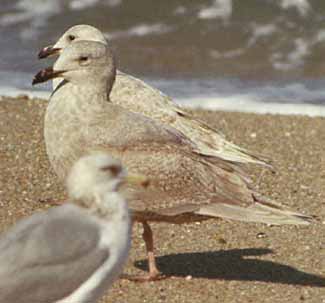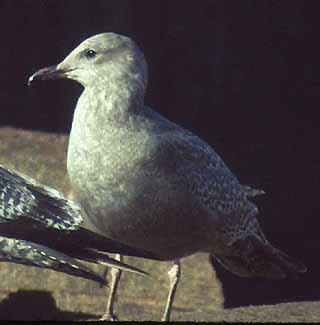MISIDENTIFICATION #2: "THAYER'S GULL"
 Look at the bird in the back, behind the obvious first-winter Glaucous-winged
Gull (ignore the out-of-focus Calif. Gull in foreground). The bird is question
is a pale gull in its first winter, but seems to be obviously smaller,
more round-headed, and has a more delicate bill than the Glaucous-winged
Gull. I have seen such birds called "Thayer's Gull" quite a number of times,
including by good birders looking for Thayer's Gulls on Monterey Bay boat
trips. What this photograph illustrates, however, is sexual dimorphism
in size in Glaucous-winged Gull. The larger bird is likely a male,
the smaller one likely a female. Both have short, heavy, bulbous-tipped
bills -- even though the back bird has a smaller bill (proportionate to
her smaller body), it is still an all-dark, blob-tipped bill, a shape shown
only by Western and Glaucous-winged gulls. The wingtips are the same mocha-color
as the body (almost all Thayer's Gulls have darker wingtips than this,
from brownish to blackish). More importantly, the bird lacks the checkered
body plumage of Thayer's Gull in their first winter (which is apparently
retained juvenal plumage; see below); lacks the very patterned tertials
of Thayer's; and they lack a prominent secondary bar in flight, as well
as lacking the terminal tail band of Thayer's.
Look at the bird in the back, behind the obvious first-winter Glaucous-winged
Gull (ignore the out-of-focus Calif. Gull in foreground). The bird is question
is a pale gull in its first winter, but seems to be obviously smaller,
more round-headed, and has a more delicate bill than the Glaucous-winged
Gull. I have seen such birds called "Thayer's Gull" quite a number of times,
including by good birders looking for Thayer's Gulls on Monterey Bay boat
trips. What this photograph illustrates, however, is sexual dimorphism
in size in Glaucous-winged Gull. The larger bird is likely a male,
the smaller one likely a female. Both have short, heavy, bulbous-tipped
bills -- even though the back bird has a smaller bill (proportionate to
her smaller body), it is still an all-dark, blob-tipped bill, a shape shown
only by Western and Glaucous-winged gulls. The wingtips are the same mocha-color
as the body (almost all Thayer's Gulls have darker wingtips than this,
from brownish to blackish). More importantly, the bird lacks the checkered
body plumage of Thayer's Gull in their first winter (which is apparently
retained juvenal plumage; see below); lacks the very patterned tertials
of Thayer's; and they lack a prominent secondary bar in flight, as well
as lacking the terminal tail band of Thayer's.

A real Thayer's Gull in its first winter is shown at right.
Note especially the thin bill without a prominent gonydeal
angle at the tip; the more checkered pattern to the upperwing coverts;
and the gentler head shape (almost pigeon-like). The checkered pattern
of the upperwings (most prominent on the tertials) is formed by dark centers
to the feathers contrasting with pale edges. On Glaucous-winged Gull the
contrast between the center and edges of each feather is much less. Thayer's
also show a secondary bar and a tail band in flight, but primary color
varies from black to pale brown.
Chris Corbin, Al Jaramillo, Steve Howell, and others have recently pointed
out that arctic breeding gulls -- including Thayer's, Iceland, Glaucous
(and maybe some Herring?) -- do not undergo a post-juvenal molt in the
fall as do our locally nesting gulls (e.g., Western, presumably Glaucous-winged).
Instead, these arctic-born youngsters retain juvenal plumage well into
winter, perhaps to March or April. The vast majority of the literature
(e.g., Grant, 1982, 1986, Gulls: an Identification Guide) and most
birders (including me) have been calling Thayer's Gulls (or Iceland Gulls,
etc.) in their first winter to be in "first-winter" or "first-basic" plumage,
but this terminology is apparently incorrect.
Misidentified "Thayer's Gull" are becoming more and more of a problem
as birders gain more confidence in their ability to identify gulls, despite
their lack of experience with some species. Out-of-staters often come to
Monterey looking for Thayer's Gulls, and go away having ticked a small
Glaucous-winged (if a young bird) or a Western X Glaucous-winged hybrid
if an adult is involved. The latter problem is particularly prevalent.
Lists of birds seen on Monterey Bay boat trips, and then posted on the
Internet, often include claims of many more Thayer's Gulls than were actually
present, and especially improbable are claims before early November or
after mid-April.
In truth, Thayer's Gulls are rather local in Monterey County. They are
common at gull roosts in Moss Landing and at the Little Sur R. mouth, and
at the Marina dump in winter (mostly mid-November to mid-March), but are
quite scarce elsewhere. They are regular offshore but usually beyond the
reach of an average Monterey Bay boat trip (which may actually record 1-3/trip
in winter). Thayer's are quite scarce at Pt. Pinos, and those that do occur
there tend to be birds in their first winter (i.e., juvenal plumage).
PHOTOS: The first-winter Glaucous-winged
Gulls
were at Pt. Pinos, Monterey Co., on 18 Jan 1980; the juv.
Thayer's
Gull was photographed by J. Van Remsen, Jr., in San Diego in Dec
1975. Photos © D. Roberson and J. Van Remsen, Jr., respectively.
TOP
BACK TO TEN
MOST MISIDENTIFIED PAGE
GO TO MONTEREY PAGE
GO TO
IDENTIFICATION PAGE
GO TO HOME PAGE
GO TO LIST OF BIRD
FAMILIES OF THE WORLD
GO TO BIRDING THE
WORLD PAGE
end
 Look at the bird in the back, behind the obvious first-winter Glaucous-winged
Gull (ignore the out-of-focus Calif. Gull in foreground). The bird is question
is a pale gull in its first winter, but seems to be obviously smaller,
more round-headed, and has a more delicate bill than the Glaucous-winged
Gull. I have seen such birds called "Thayer's Gull" quite a number of times,
including by good birders looking for Thayer's Gulls on Monterey Bay boat
trips. What this photograph illustrates, however, is sexual dimorphism
in size in Glaucous-winged Gull. The larger bird is likely a male,
the smaller one likely a female. Both have short, heavy, bulbous-tipped
bills -- even though the back bird has a smaller bill (proportionate to
her smaller body), it is still an all-dark, blob-tipped bill, a shape shown
only by Western and Glaucous-winged gulls. The wingtips are the same mocha-color
as the body (almost all Thayer's Gulls have darker wingtips than this,
from brownish to blackish). More importantly, the bird lacks the checkered
body plumage of Thayer's Gull in their first winter (which is apparently
retained juvenal plumage; see below); lacks the very patterned tertials
of Thayer's; and they lack a prominent secondary bar in flight, as well
as lacking the terminal tail band of Thayer's.
Look at the bird in the back, behind the obvious first-winter Glaucous-winged
Gull (ignore the out-of-focus Calif. Gull in foreground). The bird is question
is a pale gull in its first winter, but seems to be obviously smaller,
more round-headed, and has a more delicate bill than the Glaucous-winged
Gull. I have seen such birds called "Thayer's Gull" quite a number of times,
including by good birders looking for Thayer's Gulls on Monterey Bay boat
trips. What this photograph illustrates, however, is sexual dimorphism
in size in Glaucous-winged Gull. The larger bird is likely a male,
the smaller one likely a female. Both have short, heavy, bulbous-tipped
bills -- even though the back bird has a smaller bill (proportionate to
her smaller body), it is still an all-dark, blob-tipped bill, a shape shown
only by Western and Glaucous-winged gulls. The wingtips are the same mocha-color
as the body (almost all Thayer's Gulls have darker wingtips than this,
from brownish to blackish). More importantly, the bird lacks the checkered
body plumage of Thayer's Gull in their first winter (which is apparently
retained juvenal plumage; see below); lacks the very patterned tertials
of Thayer's; and they lack a prominent secondary bar in flight, as well
as lacking the terminal tail band of Thayer's.
